Chandi Borobudur (9) บุโรพุทโธ เกาะ ชวา 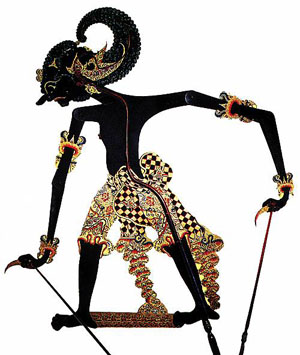 Wayang kulit East Java Indonesia.  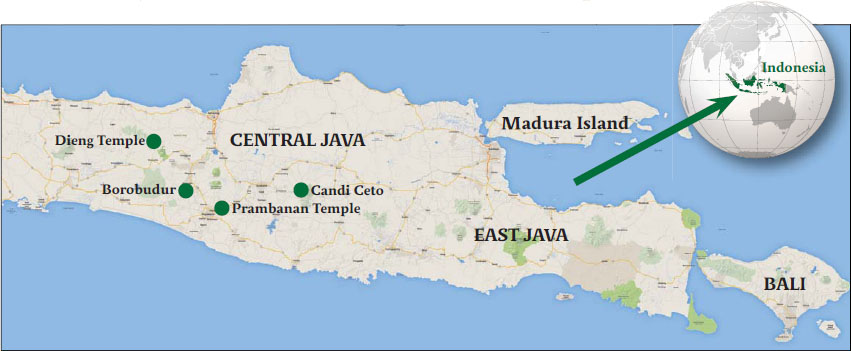 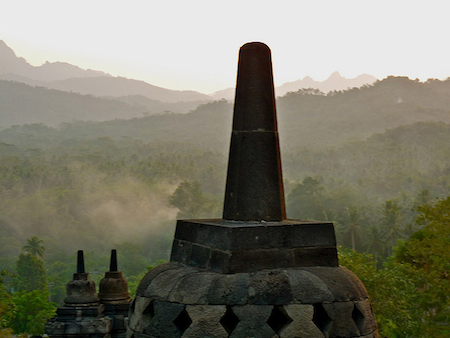 A big destination of Buddhist pilgrimage. บุโรพุทโธของเกาะชวาเป็นเส้นทางแสวงบุญแห่งหนึ่งของชาวพุทธ ดิฉันได้มาเห็นศาสนสถานที่ใหญ่ และงดงามแห่งหนึ่งในโลก Borobudur, or Barabudur (Indonesian: Candi Borobudur, Javanese:, translit. Candhi Barabudhur) is a 9th-century Mahayana Buddhist temple in Magelang, Central Java, Indonesia, and the world's largest Buddhist temple. The temple consists of nine stacked platforms, six square and three circular, topped by a central dome. It is decorated with 2,672 relief panels and 504 Buddha statues. The central dome is surrounded by 72 Buddha statues, each seated inside a perforated stupa. Built in the 9th century during the reign of the Sailendra Dynasty, the temple design follows Javanese Buddhist architecture, which blends the Indonesian indigenous cult of ancestor worship and the Buddhist concept of attaining Nirvana. The temple demonstrates the influences of Gupta art that reflects India's influence on the region, yet there are enough indigenous scenes and elements incorporated to make Borobudur uniquely Indonesian.[ The monument is a shrine to the Lord Buddha and a place for Buddhist pilgrimage. The pilgrim journey begins at the base of the monument and follows a path around the monument, ascending to the top through three levels symbolic of Buddhist cosmology: Kāmadhātu (the world of desire), Rupadhatu (the world of forms) and Arupadhatu (the world of formlessness). The monument guides pilgrims through an extensive system of stairways and corridors with 1,460 narrative relief panels on the walls and the balustrades. Borobudur has the largest and most complete ensemble of Buddhist reliefs in the world. Evidence suggests Borobudur was constructed in the 9th century and abandoned following the 14th-century decline of Hindu kingdoms in Java and the Javanese conversion to Islam. Worldwide knowledge of its existence was sparked in 1814 by Sir Thomas Stamford Raffles, then the British ruler of Java, who was advised of its location by native Indonesians. Borobudur has since been preserved through several restorations. The largest restoration project was undertaken between 1975 and 1982 by the Indonesian government and UNESCO, followed by the monument's listing as a UNESCO World Heritage Site. Borobudur remains popular for pilgrimage. Once a year, Buddhists in Indonesia celebrate Vesak at the monument, and Borobudur is Indonesia's single most visited tourist attraction. การเดินทางจากสนามบินนูราห์ ไร (Nurah Rai )ที่บาหลีใช้เวลา1 ชั่วโมง สนามบินชื่อเดียวกับเมือง ผู้คนที่มาเที่ยวชม กลับเป็น อิสลามเเป็นส่วน ใหญ่ จากการดูการแต่งกาย บุโรพุทโธ ตั้งอยู่ใจกลางเกาะชวา อยู่ห่างจากเมืองยอกยากาตาร์ (Yogyakata) ของอินโดนีเซีย ไปทางทิศตะวันตกเฉียงเหนือประมาณ 40 กิโลเมตร มหาสถูปบุโรพุทโธ หรือ บรมพุทโธ (ภาษาอินโดนีเซีย: Chandi Borobudur) เป็นสถานที่ท่องเที่ยวที่มีชื่อเสียงของประเทศอินโดนีเซีย ตั้งอยู่ในภาคกลางของเกาะชวา ห่างจากยอกยาการ์ตาไปทางตะวันตกเฉียงเหนือราว 40 กิโลเมตร สร้างขึ้นระหว่างปี พ.ศ. 1293 - 1393 โดยบุโรพุทโธเป็นศาสนสถานของศาสนาพุทธนิกายมหายาน ถ้าไม่นับนครวัดของกัมพูชาซึ่งเป็นทั้งศาสสถานของศาสนาพราหมณ์-ฮินดูและศาสนาพุทธ บุโรพุทโธจะเป็นศาสนสถานของศาสนาพุทธที่ใหญ่ที่สุดในโลก ในปีพ.ศ. 2534 องค์การยูเนสโกได้ประกาศให้บุโรพุทโธเป็นมรดกโลก โดยสร้างขึ้นจากหินลาวา มีพื้นที่โดยรวมประมาณ 55,000 ตารางเมตรรูปทรงด้านฐานเป็นสี่เหลี่ยมจัตุรัสกว้างยาวด้านละ 123 เมตร แต่ละด้านมีบันไดและซุ้มประตูขึ้นสู่มหาเจดีย์ ซึ่งมีทั้งหมด10 ชั้น ชั้น 1-6 มีลักษณะเป็นรูปสี่เหลี่ยม ส่วนชั้นที่ 7-10 มีลักษณะเป็นรูปทรงกลม ส่วนฐานของบุโรพุทโธประกอบด้วยขั้นบันไดใหญ่ 4 ขั้น กำแพงรอบฐานมีภาพสลักประมาณ 160 ภาพ เป็นภาพที่แสดงให้เห็นถึงความเป็นมนุษย์ที่ยังข้องอยู่ในกาม ผูกพันกับความสุข สนุกสนาน ความปรารถนาทางโลกอันไม่รู้จบ ส่วนนี้จัดอยู่ในขั้นกามภูมิ ในส่วนที่สอง คือส่วนบนของฐานนั้น ผนังทั้งด้านนอกด้านในมีรูปสลักเรื่องราวเกี่ยวกับพุทธประวัติและชาดกต่างๆ ประมาณ1,460 ภาพในส่วนนี้ถือเป็นขั้นรูปภูมิ คือขั้นตอนที่มนุษย์หลุดพ้นจากกิเลสทางโลกมาได้บางส่วน ส่วนที่สามคือส่วนของฐานกลมที่มีเจดีย์ทรงระฆังคว่ำ จำนวน 72 องค์ แต่ละองค์บรรจุด้วยพระพุทธรูป ตั้งเรียงรายอยู่ 3 ระดับ โอบล้อมพระเจดีย์องค์ใหญ่ซึ่งเป็นสัญลักษณ์สุดยอดของบุโรพุทโธ จำนวน 72 นั้น หากพิจารณาในทางธรรมแล้วหมายถึง รูป 18 เจตสิก 52 จิต 1 นิพพาน 1 และฐานพระเจดีย์ที่เป็นรูปบัวผลิบานนั้นบ่งบอกถึงการรู้ตื่นและเบิกบาน ส่วนพระเจดีย์องค์ใหญ่นั้นภายในไม่ได้บรรจุสิ่งใดไว้ อาจสื่อให้เห็นถึง ความว่าง อันถึงที่สุดของนิพพานแล้ว ย่อมไร้ลักษณ์ ไร้รูปรอยใดๆ ในส่วนนี้ถือเป็นขั้นอรูปภูมิ ที่มนุษย์ไม่ผูกพัน กับทางโลกอีกต่อไป บุโรพุทโธ1.ใน7 สิ่งมหัศจรรย์ในโลก : Borobudur Temple สถานที่ตั้ง บนเนินสูงของเกาะชวาภาคกลาง ประเทศอินโดนีเซีย ปัจจุบัน สามารถเข้าเยี่ยมชมได้ บุโรพุทโธ ( Borobudur ) พุทธสถานอันศักดิ์สิทธิ์ที่สร้างมาตั้งแต่ศตวรรษที่ 8-9 โดยกษัตริย์ราชวงศ์ไศเลนทร ตั้งอยู่บนเนินสูงของเกาะชวาภาคกลาง ห่างจากเมืองยอกยากาตาร์ ( Yogyakata ) ไปทางทิศตะวันตกเฉียงเหนือประมาณ 40 กิโลเมตร ถือเป็นโบราณสถาานขนาดใหญ่ และเป็นศูนย์รวมแห่งความภาคภูมิใจของชาวอินโดนิเซีย และชาวพุทธทุกคน ซึ่งหวังจะไปแสวงบุญสักครั้งหนึ่งในชีวิต เจดีย์บุโรพุทโธรูปทรงดอกบัวนี้ก่อสร้างตามแบบศิลปะฮินดู-ชวา หรือศิลปะชวาภาคกลางที่ผสมผสาานระหว่างอินเดียและอินโดนีเซียได้อย่างกลมกลืนที่สุด บุโรพุทโธเปรียบเป็นศูนย์กลางของจักรวาลซึ่งแบ่งเป็น 3 ชั้น ส่วนฐานของเจดีย์ประกอบด้วยขั้นบันไดใหญ่ 4 ขั้น รอบ ๆ เป็นรูปสี่เหลี่ยม กำแพงรอบฐานมีภาพนูนตำไม่น้อยกว่า 160 ภาพส่วนนี้อยู่ในขั้นกามาธาตุ หรือขั้นตอนที่มนุษย์ยังผูกพันอย่างใกล้ชิดกับความสุขความร่ำรวยทางโลก ส่วนที่สอง คือส่วนบนของฐานที่มีบันไดรูปกลม ฐาน 6 ชั้นที่มีรูปสลักนูนต่ำเกือบ 1,400 ภาพที่แสดงพุทธประวัติ ถือเป็นขั้นรูป ธาตุ คือขั้นตอนที่มนุษย์หลุดพ้นจากกิเลสทางโลกมาได้บางส่วน ส่งวนที่สามคือส่วนของฐานกลมที่มีเจดีย์เล็ก ๆ 3 ขั้นล้อมรอบสถูปองค์ใหญ่ทึ่สุดที่หมายถึงจักรวาล คือขั้นอรูปธาตุ ที่มนุษย์ไม่ผูกพันกับทางโลกอีกต่อไป ปัจจุบันบุโรพุทโธจัดเป็นมรดกของยูเนสโกที่มีความลี้ลับมหัศจรรย์ทั้งทาง ด้านการก่อสร้างสถาปัตยกรรมรูปทรงภายนอก และมหัศจรรย์ในด้านสัญลักษณ์และความหมายที่รอให้มนุษย์ได้ศึกษาตีความกันต่อ ไป :: อ้างอิง วารสารเที่ยวรอบโลก ปีที่ 15 ฉบับ 169 กันยายน 2539 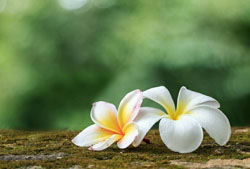 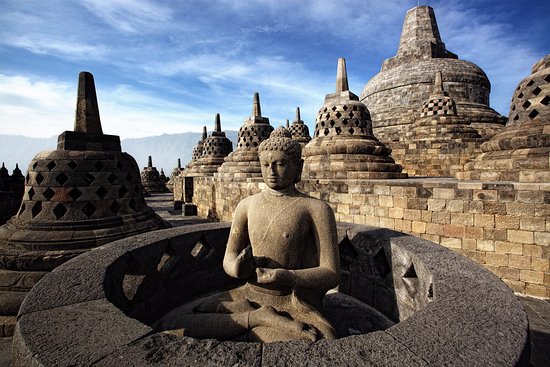 Chandi Borobudur was registered as the World Heritage Site in 1991 by UNESCO. It is the cultural legacy that deserves respect since it is a civilized structure with the age of more than 1,000 years and also it is a tourist attraction that the touristrists from all over the world come to pay a visit the most in Indonesia because taking a walk around the place will give you the feeling of traveling back tos from all over the world come to pay a visit the most in Indonesia because taking a walk around the place will give you the feeling of traveling back to the past, in the reign of Sailendra Dynasty which took 2 million square feet of volcanic rocks to build the square base with the width of 121 meters and the height of 403 feet in Pyramid-shape. The architecture was influenced by Sailendras arts which is different from other archaeological sites of Java. Borobudur tool approximately about 70 years of construction since the reign of King Vishnu to King Indra. The perfect arts combination of Central Java and Indian makes this place amazing. 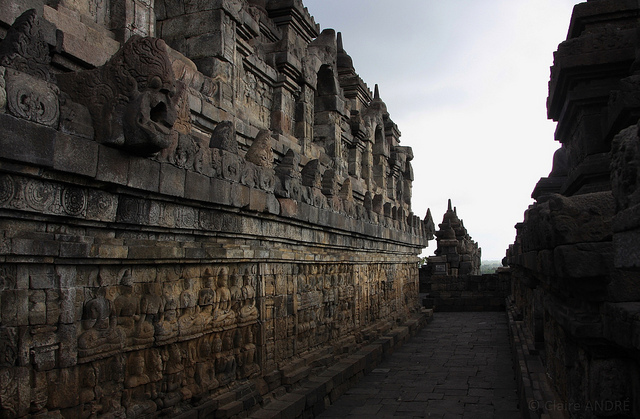 Borobudur and the concept of path in Buddhism Paths have been pervasive in human civilization. We are all familiar with the streets, trails, and lanes along which we routinely travel. Ancient Roman roads are utilized in some places even today. In contemporary computer culture we follow paths on webpages as we find our way to the information or experience we are searching for or find unexpectedly. There are simulated paths in complex first-person virtual reality video environments, where role-playing games formulate their content around the path to be conquered. The idea of path is an important concept in Buddhism, and is essential in understanding the meaning and purpose of one of the most remarkable and impressive monuments in the world: Borobudur. 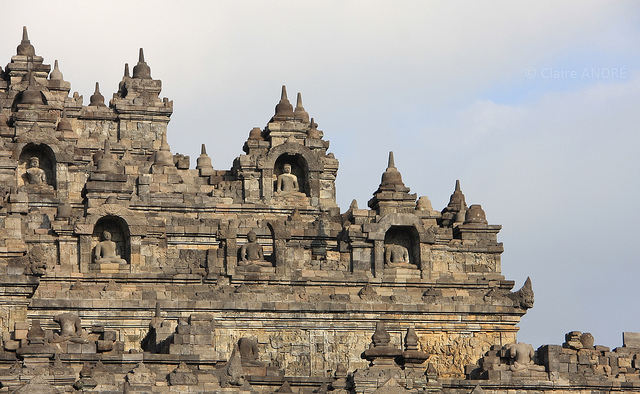 Located on the island of Java in Indonesia, the rulers of the Śailendra Dynasty built the Temple of Borobudur around 800 C.E. as a monument to the Buddha (exact dates vary among scholars). The temple (or candi in Javanese, pronounced chandi) fell into disuse roughly one hundred years after its completion when, for still unknown reasons, the rulers of Java relocated the governing center to another part of the island. The British Lieutenant Governor on Java, Sir Thomas Stamford Raffles, only rediscovered the site in 1814 upon hearing reports from islanders of an incredible sanctuary deep within the islands interior.  Candi Borobudurs design was conceived of by the poet, thinker, and architect Gunadharma, considered by many today to be a man of great vision and devotion. The temple has been described in a number of ways. Its basic structure resembles that of a pyramid, yet it has been also referred to as a caitya (shrine), a stupa (reliquary), and a sacred mountain. In fact, the name Śailendra literally means Lord of the Mountain. While the temple exhibits characteristics of all these architectural configurations, its overall plan is that of a three-dimensional mandalaa diagram of the cosmos used for meditationand it is in that sense where the richest understanding of the monument occurs. 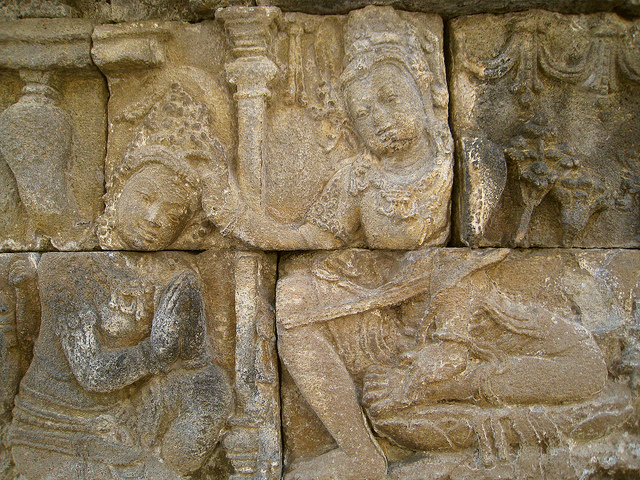 The entire site contains 504 statues of the Buddha. 1460 stone reliefs on the walls and opposite balustrades decorate the first four galleries, with an additional 1212 decorative reliefs augmenting the path. The relief sculptures narrate the Buddhas teachings (the Dharma), depict various events related to his past lives (Jataka tales), and illustrate didactic stories taken from important Buddhist scriptures (sutras). Interestingly, another 160 relief sculptures adorn the base of the monument, but are concealed behind stone buttresses that were added shortly after the buildings construction in order to further support the structures weight. The hidden narrative reliefs were photographed when they were discovered in the late 19th century before the stones were put back to help ensure the temples stability. From Strawberry darkness into light The idea of moving from the darkness into the light is the final element of the experience of Borobudur. The temples pathway takes one from the earthly realm of desire (kamadhatu), represented and documented on the hidden narratives of the structures earthbound base, through the world of forms (rupadhatu) as expounded on the narratives carved along the four galleries set at right angles, until one finally emerges into the realm of formlessness (arupadhatu) as symbolized and manifested in the open circular terraces crowned with 72 stupas.robudur, photo: Paul Atkinson (CC BY-SA 2.0) However, the symbolization of enlightenment these stupas represent is not intended to be merely aesthetic. Buddhist stupas and mandalas are understood as spiritual technologies that harness spiritual energies in the creation of sacred space. The repetition of form and the circumabulatory progress of the pilgrim mimic, and thereby access, the cosmological as a microcosm. The clockwise movement around the cosmic center reproduces the macrocosmic path of the sun. Thus, when one emerges from the dark galleries representing the realms of desire and form into the light of the formless circular open air upper walkways, the material effect of light on ones physical form merges concomitantly with the spiritual enlightenment generated by the metaphysical journey of the sacred path. Light, in all its paradoxes, is the ultimate goal. The crowning stupa of this sacred mountain is dedicated to the Great Sun Buddha Vairocana. The temple sits in cosmic proximity to the nearby volcano Mt. Merapi. During certain times of the year the path of the rising sun in the East seems to emerge out of the mountain to strike the temples peak in radiant synergy. Light illuminates the stone in a way that is intended to be more than beautiful. The brilliance of the site can be found in how the Borobudur mandala blends the metaphysical and physical, the symbolic and the material, the cosmological and the earthly within the structure of its physical setting and the framework of spiritual paradox. Essay by Robert E. Gordon 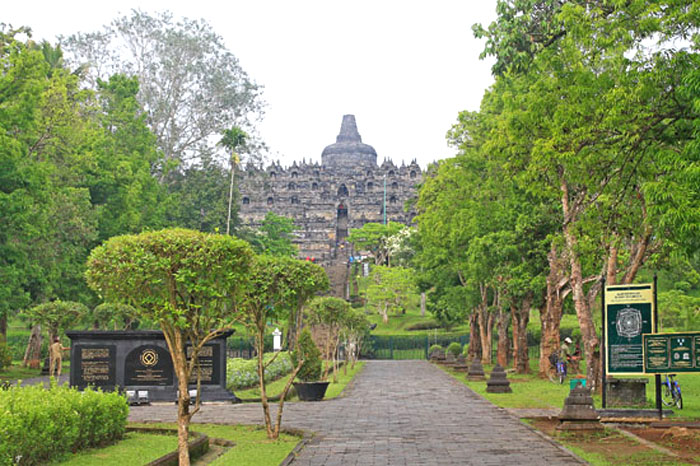 Thank you videos :Studio Sunday, WorldSiteGuides Pictures and Essay from Khan Academy  Strawberry from Bandung west Java Indonesia. อลังการงานสร้าง..
ดูแล้วมาคิดถึงปราสาทหินพนมรุ้งบ้านเราเลย ... ไปบาหลีก็หลายหน แต่ไม่เคยได้ไปที่นี่เลย ต้องกลับมาทบทวนใหม่ ..ไปทีไรก้งานมาก่อนทุกที... ชอบตรงของแถมที่เป็นรูปวาดน่ะ... โดย: ผู้หญิงที่มาจากโลกสีคราม (girl from sea
 ) วันที่: 1 กันยายน 2551 เวลา:9:19:31 น. ) วันที่: 1 กันยายน 2551 เวลา:9:19:31 น.รูปที่วาดนี่ยินดีมอบให้ใครที่สนใจเอาไปประมูลการกุศล
ช่วยเหลือเด็กเรียน หรือคนเจ็บป่วย ทั้งเอกชน หรือภาครัฐ ทุกแห่งในโลกค่ะทุกรูปแบบ ทุกเงื่อนไข โดยมีข้อแม้ว่าคุณ จะต้องมีค่าขนส่ง ทาง Fedex ถ้าคุณไม่ได้อยู่ในประเทศไทย เพราะเขาจะมีประกันให้ ค่าส่งมาตรฐาน และเ็ร็วมาก ภาพวาดบาหลีทั้งหมดมี78 ภาพค่ะ ++ ติดต่อมานะคะ.... โดย: Cheria (SwantiJareeCheri
 ) วันที่: 8 กันยายน 2551 เวลา:8:10:45 น. ) วันที่: 8 กันยายน 2551 เวลา:8:10:45 น.ดูไปขนลุกไปและทราบซึ้งมากครับ งานก่อสร้างที่ผสมเอาแรงแห่งศรัทธามาเป็นพลังในการสร้าง...
โดย: bite25
 วันที่: 10 กันยายน 2551 เวลา:10:18:00 น. วันที่: 10 กันยายน 2551 เวลา:10:18:00 น.ไม่ทราบว่าได้ชื่อภูเขาไฟ หรือยังครับ
ในรูปวาด มีภูเขาไฟ สาม ลูก ลูกแรกด้านหน้า ชื่อ Batox หรือ บาต็อกส์ ลูกที่มีควันออกมา ชื่อ โบรโม่ Bromo ลูกข้างหลังสุด ชื่อ สุเมรุ Sumeru เห็นมีควันพ่นออกมา สูงที่สุดในสามลูกนี้ โดย: n416 IP: 118.173.132.74 วันที่: 3 มิถุนายน 2553 เวลา:16:47:30 น.
ขอบคุณมากๆค่ะ สำหรับชื่อภูเขาไฟ ดิฉันกลับไปบาหลีอีกครั้งกับ A window through the sky.. Kintamai คุณน่าจะชอบนะคะ อยู่ไหนคะนี่ Email: svantee@rocketmail.com  โดย: Cheria (SwantiJareeCheri
 ) วันที่: 16 กันยายน 2553 เวลา:20:12:52 น. ) วันที่: 16 กันยายน 2553 เวลา:20:12:52 น. |
SwantiJareeCheri
 ผู้ติดตามบล็อก : 2 คน [?] ผู้ติดตามบล็อก : 2 คน [?]
All Blog
|
|||
| Pantip.com | PantipMarket.com | Pantown.com | © 2004 BlogGang.com allrights reserved. | ||||



อยากไปสักการะสักครั้งจัง
ภูเขาก็สวยมากๆครับ ....